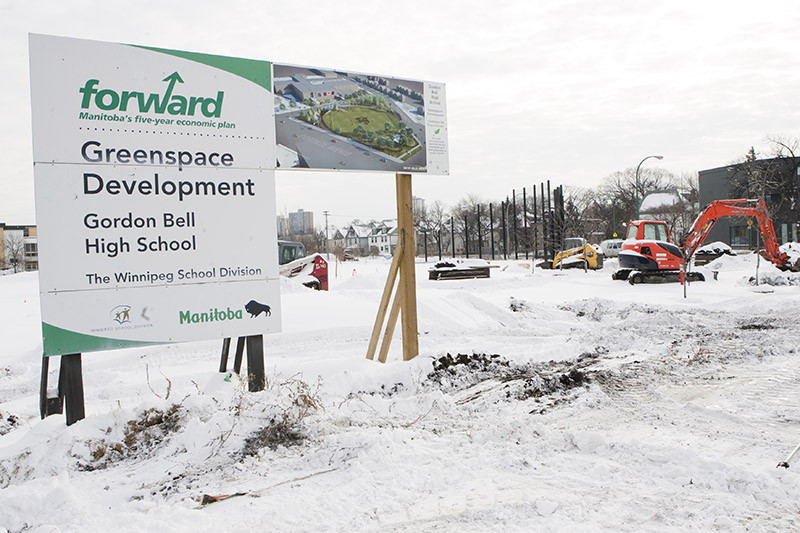University project revisits Gordon Bell field acquisition saga
Grassroots movement leaders discuss lessons, frustrations encountered along the way
It began with one impassioned voice and grew into a student movement that is seeing sod replace concrete at the corner of Broadway and Portage.
Now, the University of Winnipeg’s Institute for Urban Studies is revisiting the sequence of events that saw Gordon Bell High School find grassroots success with good, old-fashioned citizen activism.
The high school is the subject of the first installment of In-Brief, a series of booklets the institute is releasing on community engagement in Winnipeg.
Mike Maunder, who headed the first volume of In-Brief, says the Gordon Bell tale was too interesting to pass up.
“It was a small story, but an important one,” said Maunder. “It shows us it’s possible for a determined group of citizens to actually affect government.”
The saga began in 2008 with the suggestion that Gordon Bell High School, whose downtown location offered students zero green space, acquire an adjacent property to transform it into a field for outdoor activities.
Within the year, and countless rallies, protests and petitions later, the province buckled under demands to purchase the land from Canada Post, who had plans to turn the lot into a mail-processing facility.
In the project, Maunders identifies Gordon Bell alumnus Nancy Chippendale as the overall movement’s initial catalyst for change.
“I thought about this for many years,” said Chippendale, who first suggested in a Winnipeg Free Press editorial that the school get the lot. “I would drive past Kelvin and see their big field, then by Gordon Bell and see nothing but pavement.”
Despite the movement’s eventual success, Chippendale can’t help but wish the lot was better used in the first place.
“ It was a small story but an important one. It shows us it’s possible for a determined group of citizens to actually affect government.
Mike Maunder, Institute for Urban Studies
“So much expense, worry and concern could have been prevented if inner-city ridings in Winnipeg were valued like suburban ones,” said Chippendale, who believes area politicians could have been more proactive in acquiring the land for students.
“The provincial government could have put up a few million dollars and bought that field all along.”
Still, the process of actively pressuring government to make change was a good thing for students, who have raised more than $300,000 to help redevelop the site.
Morgan Hoogstraten, who graduated from Gordon Bell in 2009, played a key role in rallying students.
Now working as a fundraiser for World Vision, Hoogstraten says she learned a lot from her trial-by-activism.
“It was me proving to myself I could consciously manifest change in reality,” she said. “I’ve been carrying that with me ever since.”
Hoogstraten, who attended weekly protests at the Legislative Building alongside Chippendale and her peers, says she’s excited to see the positive impact the new field will have on the community.
“I’m really hoping (the field) will act as a place where downtown kids can go and enjoy themselves, and blow off steam without getting into trouble because there’s nothing else to do,” she said.
“I expect the school spirit will really strengthen and its sports teams will flourish.”
Construction on the new field, which began in the spring, is set for completion sometime next year.
To learn more, visit Going Old School: Activism Reborn in Winnipeg’s Inner City at www.uwinnipeg.ca/index/ius-publications.
Published in Volume 67, Number 11 of The Uniter (November 14, 2012)







